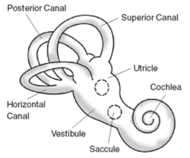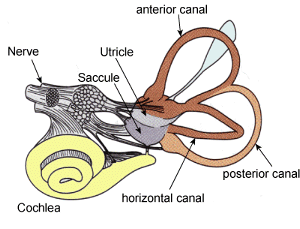Our Balance System
Integration of the occulomotor system, the vestibular system and the somatosensory system, along with muscle strength in our support limbs create our system of balance. A disturbance in any one or more of the systems can lead to feelings of dizziness, vertigo, loss of balance and falls.
Vestibular System
The vestibular system, which contributes to our balance and our sense of spatial orientation, is the sensory system that provides the dominant input about movement and equilibrioception. Together with the cochlea, a part of the auditory system, it constitutes the labyrinth of the inner ear, situated in the vestibulum in the inner ear (Figure 1). As our movements consist of rotations and translations, the vestibular system comprises two components: the semicircular canal system, which indicate rotational movements; and the otoliths, which indicate linear accelerations. The vestibular system sends signals primarily to the neural structures that control our eye movements, and to the muscles that keep us upright. The projections to the former provide the anatomical basis of the vestibulo-ocular reflex, which is required for clear vision; and the projections to the muscles that control our posture are necessary to keep us upright.

 Figure 1 The labyrinth of the inner ear, from the left ear. It contains i) the cochlea (yellow), which is the peripheral organ of our auditory system; ii) the semicircular canals (brown), which transduce rotational movements; and iii) the otolithic organs (in the blue/purple pouches), which transduce linear accelerations. The light blue pouch is the endolymphatic sac, and contains only fluid.
Figure 1 The labyrinth of the inner ear, from the left ear. It contains i) the cochlea (yellow), which is the peripheral organ of our auditory system; ii) the semicircular canals (brown), which transduce rotational movements; and iii) the otolithic organs (in the blue/purple pouches), which transduce linear accelerations. The light blue pouch is the endolymphatic sac, and contains only fluid.
Supporting Research
-
Benign Paroxysmal Positional Vertigo (contains excellent diagrams of maneuvers)




Toolbox
Acute
Anatomy
Articles
Assessment Tools
Cardiac
Coding/Reimbursement
Courses
Disease Specific
Documentation
Evidence Based Practice (EBP)
Geriatrics
Home Health
Journal Search Engines
Manual Techniques
Modalities
Outpatient
Pain
Patient Handouts
Pediatrics
Pharmacology
PT Websites
Rehab
Research
Therapeutic Exercise
Wound Care